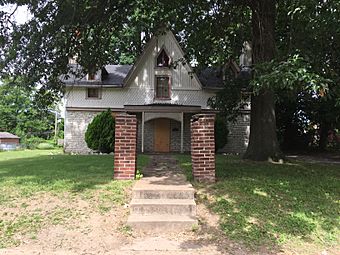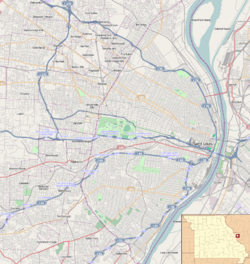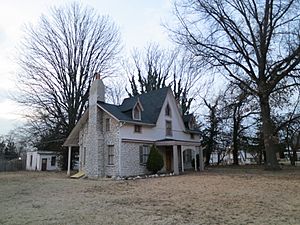Emmanuel DeHodiamont House facts for kids
Quick facts for kids |
|
|
Emmanuel DeHodiamont House
|
|

Emmanuel DeHodiamont House in 2017
|
|
| Location | 951 Maple Place, St. Louis, MO, United States |
|---|---|
| Area | less than one acre |
| Built | 1830 |
| Architectural style | Gothic Revival |
| NRHP reference No. | 02001708 |
| Added to NRHP | January 15, 2003 |
The Emmanuel DeHodiamont House is a very old house in the West End area of St. Louis, Missouri. It was first built around 1830 by a farmer named Emmanuel DeHodiamont. Later, around 1875, it was updated to look like the Gothic Revival style.
This house is special because it's one of the oldest homes still standing in St. Louis. It shares this title with the Lewis Bissell House. It's also the oldest building in St. Louis that is still owned by private people. The house was named a St. Louis Landmark in 1966. It was also added to the National Register of Historic Places on December 4, 2002.
The House's Story
Emmanuel DeHodiamont and his wife, Caroline, bought a large piece of land in 1829. This land was about 180 acres and included parts near the River Des Peres. There are no records to show exactly when the house was built. However, people believe DeHodiamont built it soon after he bought the land.
Sadly, Emmanuel's wife died shortly after they moved in. He got married again in 1833. But his new wife left him in 1836, and they got divorced. Emmanuel kept farming his land until 1871. Then, he sold the house and the land around it to people who bought land to sell it later.
These buyers thought a railroad would be built from St. Louis. A railroad was indeed built in 1875. By that time, the house and its 57 acres were divided into a new area called Maryville. It was probably around this time that the house got its unique Gothic Revival look.
New homes were built slowly in this area at first. But by the 1890s, most of the land was sold and developed. The houses around the DeHodiamont House were built during this time. Some of the 1890s houses were torn down and rebuilt in the 1960s.
House Design and Style
The oldest part of the house, built in 1830, is a stone house. It has one and a half stories and measures about 20 by 40 feet. The stone walls are very thick, almost two feet! The house still has its two original chimneys at each end.
The top part of the house, the second story, is made of wood. The middle of the house has a tall, pointed roof called a gable. Both of these parts were added in 1875. The doors and windows on the first floor are still in their original spots from the 1830 design.
Later, in 1890 and 1906, brick kitchens were added to the back of the house. Inside, the first floor has two rooms that are almost the same. A hallway with a staircase divides them. The room on the north side connects to the kitchen at the back. Upstairs, there are two bedrooms, also very similar. In the backyard, there's a brick garage built in 1904. This garage is also considered an important part of the historic property.
Why This House Is Important
The Emmanuel DeHodiamont House is important for two main reasons. First, it's an "exceptionally early stone house." Many stone houses were built in St. Louis before the 1850s. But most of them were torn down as the city grew.
Second, it's a "rare example of the early Gothic Revival style in St. Louis." Not only is it an old stone house, but it's also one of the earliest known houses still standing in St. Louis. It is also officially recognized as a St. Louis City Landmark.





